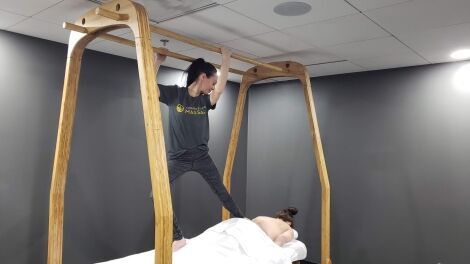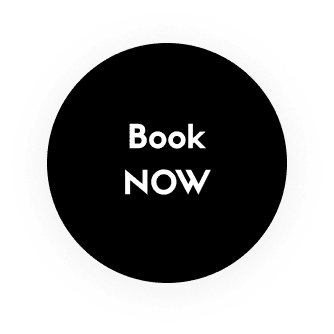Ashiatsu Massage Downtown Edmonton
Deep, Restorative Relief Through Barefoot Pressure
Ashiatsu is a specialized form of massage often compared to deep tissue therapy. Unlike traditional massage, the therapist uses their feet instead of their hands and arms, delivering broad, firm, and consistent pressure across the body. This technique, sometimes referred to as “back walking,” allows for deeper muscle engagement without discomfort.
Rooted in traditional healing practices taught by yogi masters, Ashiatsu Massage helps mobilize your body, reduce tension, and improve range of motion. Sessions may also incorporate elements of Thai massage, including stretching, acupressure, twisting, and joint mobilizations, creating a powerful blend of relaxation and therapeutic results.
45 min | 60 min | 90 min | 120 min

your first massage!
- 780-433-0550
- 10068 108 St NW Edmonton, AB T5J 5G8
- Open Today until 8:00 pm
What to Expect During Your Ashiatsu Massage Appointment
If you experience general aches and pains, repetitive strain, or complex issues caused by injury, Ashiatsu Massage in Downtown Edmonton may be the right choice for you.
Your session will begin with a brief assessment that may include range-of-motion testing. Your therapist will review your health history and any concerns you’d like to address. You will not need to undress for this treatment, but it’s best to wear comfortable, athletic-style clothing that allows for easy movement.
During the massage, your therapist will use an overhead bar system to balance and support themselves while applying pressure with their feet. This unique technique allows for deeper, broader pressure than traditional massage. Depending on your needs, your session may include elements such as deep tissue work, acupressure, stretching, twisting, and joint mobilizations. Because of the intensity and depth, Ashiatsu sessions may take longer than standard treatments and are performed on a reinforced massage table equipped with overhead support bars.
Some tenderness or mild discomfort may occur, particularly if you have areas of tightness or chronic tension. Communication is key—your therapist will adjust pressure and technique to ensure the treatment is safe and effective for your needs. Please note that not every condition requires deep pressure, and your therapist will tailor the approach to address the root of your concern.
After your session, you can expect to feel relaxed and revitalized. It is important to stay hydrated to help your body process any toxins released during the treatment. Your therapist may also recommend aftercare strategies, including remedial exercises, gentle stretching, or self-massage techniques, to support your continued progress. If appropriate, a follow-up appointment may be suggested to help you stay on track with your wellness goals.
Additional Information for Your Ashiatsu Massage Appointment
If you’re planning on receiving an Ashiatsu Massage, here are a few helpful tips to make the most of your session:
Arrive early: Plan to arrive a few minutes before your appointment. This gives you time to complete any paperwork and settle in comfortably before your treatment begins.
Eat light beforehand: Avoid large meals prior to your massage, as a full stomach can make it harder to relax. A light meal one to two hours before your appointment is ideal, but don’t arrive on an empty stomach.
Stay hydrated: Drink plenty of water before and after your session. Staying hydrated helps your body flush out toxins and minimizes post-treatment soreness.
Dress comfortably: Depending on the type of treatment, you may or may not need to undress to some extent. Loose, athletic-style clothing is recommended to allow free movement. Your therapist will guide you on what’s best for your session.
Communicate openly: Share any areas of discomfort or tension with your therapist during the massage. Open communication helps your therapist adjust techniques and pressure for your comfort and best results.
Take it easy afterwards: Allow your body time to rest and recover following the massage. Avoid strenuous exercise or heavy physical activity immediately after treatment to maximize the benefits.
Follow aftercare advice: Your therapist may recommend stretches, self-care techniques, or follow-up sessions tailored to your needs. Following these instructions will help you maintain the positive results of your treatment.
Click the BOOK NOW button to schedule your Ashiatsu Massage appointment today in Downtown Edmonton. Our registered massage therapists are ready to get you back to feeling your best.
- I had a great experience with Chaimongkon(CK H.) during my massage session. He was incredibly skilled, attentive, and immediately understood the issue I was dealing with. His confidence and expertise...
- My massage appointment with Mason was excellent . After the first session, my body felt incredibly light and relaxed. Unlike other massage studios and therapists , Mason took the time to understand my...
- Daisy is a wonderful massage therapist at Athlete’s Choice. She is an athlete herself, and was able to understand the things I needed to work on. She also helped me connect the dots on why an injury...
- I came in to see Tracy, for the first time. I told her I had been experiencing what I can only describe as severe neck/back tension and flaring burning back pain, probably from a sitting on my desk...
- Went three times with three different therapists. Really wanted to like it since it’s convenient and they often have openings! First appointment was delayed because they had issues with my coverage...
Frequently Asked Question
Ashiatsu is a deep, flowing style where your therapist uses clean, supported foot pressure to deliver broad, even strokes. In our Downtown Edmonton clinic, overhead bars help your therapist control pressure so it feels deeply relaxing while releasing stubborn tension.
Yes, when performed by trained therapists. In Downtown Edmonton, we tailor the pressure to your body and use slow, gliding compressions that spread force over a wider area, which many people find more comfortable than pointy elbow or thumb work.
You will be draped on the table like a typical massage. For your Downtown Edmonton appointment, arrive in comfortable clothes and undress to your comfort level; your therapist will ensure professional draping at all times.
You can book 45, 60, 90, or 120 minutes in Downtown Edmonton. Many clients feel noticeable relief after one session, while chronic tension often improves with a short series, then maintenance as needed.
Hydrate, take a light walk, and do gentle mobility later in the day. Your Downtown Edmonton therapist may give simple stretches for the hips, back, and shoulders to help you keep the loose, open feeling longer.
Looking for more details about our team, services, and hours? Visit our main Athlete’s Choice Massage Downtown Edmonton page.



